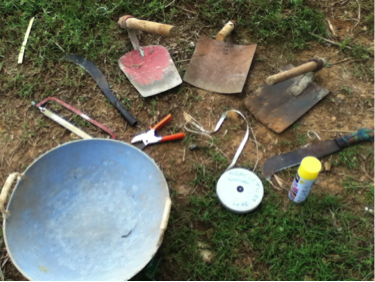
Principle: Increase energy efficiency
Permaculture communities strive for energy self-sufficiency – to generate power on their own and work to conserve it. This chapter brushes over a few basic tools, innovations and strategies useful for generating and conserving energy in a permaculture site.
Hand tools
A hand tool is a tool which only requires human power. There are many types of hand tools used in permaculture. Examples of hand tools include: Hoe, shovel, pick-axe, machete, buckets (large and small), rake, handsaw, axe, secretors, box cutters/pocket knife, hammer/nails, wire cutters, pitchfork, garden fork, earth tamper, vice, measuring tape.
Machine tools
Machine tools operate using electricity or a generator. Examples of machine tools used in permaculture are: Drill, circular saw, grinder, wood chipper, cement mixer, chainsaw, welding machine, generator, electric sander.
Heavy machinery
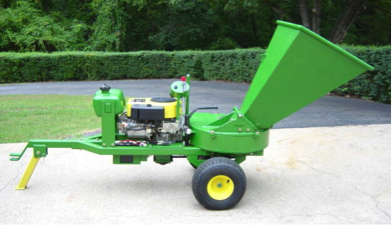
Heavy machinery includes large equipment that can do more work because of their larger size. They usually require gasoline or other consumable fuels. Renting or using heavy machinery can save time and labor. Examples of heavy machinery are excavators, bulldozers, cranes, graders, hydraulic tampers, grain grinders or other food-processing equipment.
Simple machines
These are six simple machines used by people. Knowing about, understanding and using these simple machines could help lift or move heavy loads, or other infrequent but important challenges. Here are brief descriptions of simple machines:
Lever
A lever is a simple machine that has a line that rests on a point. Place a load on one end and use force on the other. The force lifts the load. Example: Seesaw, scissors. Here’s a video demonstrating a level machine lifting bricks: http://www.youtube.com/watch?v=8a9adBsGYDk (watch at 10:30).
Ramp
An inclined plane is a ramp. It has a slanted surface and helps you move things from lower to higher places. Moving something up a ramp takes less force. Example: handicap ramp.
Screw
A screw is an inclined plane wrapped around a column. Screws are used to attach things together, can be used to draw water from a well among many other innovations. A wood screw is an example.
Wedge
A wedge is two inclined planes. It has a tapered end and a wide end. It is used to cut or split objects. Example: Axe.
Pulley
A pulley changes the direction of the force. A pulley consists of rope and a wheel. When you pull the rope, it lifts the load. Example: Flagpole
Wheel and axle
A wheel turns around a center rod that is called an axle. A wheel and axle is actually a lever that turns. Wheels make our work easy because they roll. Example: wheel.
Light
Solar Panels
Solar panels collect energy from the sun and convert it to useable electricity. In addition to solar panels, to harness solar energy you need a charge controller, inverter, and a place to store (i.e. batteries) or send the electricity (i.e. plug into the local grid).
Solar bottle lights
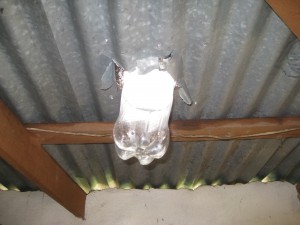
Solar bottle lights are plastic bottles filled with water and fitted into holes on top of houses. The refraction of the light on the water during the day provides enough light to light a room. This innovation has been installed in over 1 million homes in developing countries where day lighting is unavailable. Here is a link for more information: http://www.bbc.co.uk/news/magazine-23536914.
Motion – Bicycle power
The motion of a bicycle can be utilized for elements requiring a rotational movement. Some useful variations include a water pump (see Water), sand sifter, laundry machine, mixer or to create electricity to charge phones and laptops. Google Bicycle power or “Dynapod” for more information online.
Heat
Bio-char maker
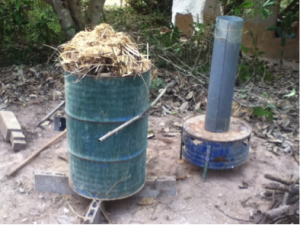
Bio-char is a type of charcoal produced using extremely high heat (around 900ºC), which provides many benefits to a permaculture site. Bio-char provides space for bacteria to latch on to as they enrich the soil, it ionizes water when used as a water filter and helps break down poop in a Humanure chamber. Also called activated charcoal, bio-char contains 9000 square feet of surface area in 1 gram or a piece the size of a pencil eraser. Add bio-char to your water filter, garden, compost and your Humanure poo chambers. Watch this TED Talk by Rob Lemer for more information on bio-char: www.youtube.com/watch?v=NrDOLx57KUU.
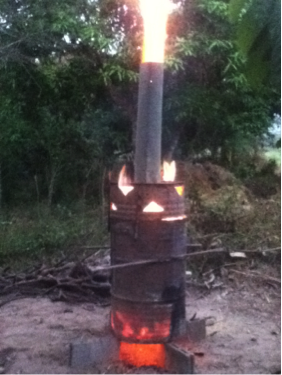
How to make a bio-char maker (sketch)
You will need 1 and ½ 200-liter metal drums, a steel pipe for a chimney. Any type of wood will make charcoal – the denser the better. As indicated in the video, make sure you seal the drum using mud after burning or else the charcoal will smolder into white ash. For step-by-step instructions on how to make a bio-char maker, watch this excellent video by Pun Pun Center for Self-Reliance in Thailand: https://vimeo.com/75699743.
Wood vinegar/charcoal maker
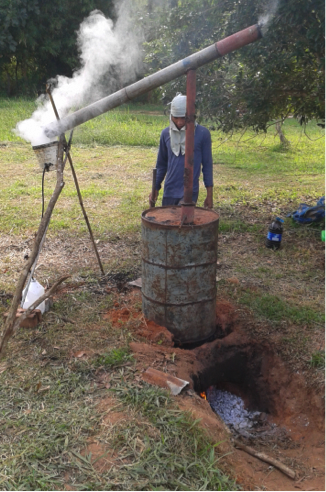
Wood vinegar is an insecticide useful for keeping pests away. It also eliminates odors from Humanure poo chambers as it smells like an oaky wood fire. Wood vinegar burns at a much lower temperature than bio-char and takes several hours to burn. The charcoal produced can be used for barbequing but doesn’t have the same properties as activated charcoal because it was produced at a lower temperature.
Similar to the construction of a bio-char maker, all you need is a 200L metal drum and a few steel pipes. 200 liters of wood (a full drum, including air gaps) produces about 10L of vinegar. The denser the wood the better. However, bamboo will still work. Dilute with water about 100:1 (water: vinegar) to get more use out of each batch.